Pros: Strong and efficient powertrains; optional AWD; simple controls; well-built interior regardless of trim
Cons: Antiquated infotainment; engines lack refinement; not as good to drive as Accord
The most recent Toyota Camry generation, the eighth in total, represented a sea change moment for the long-time, best-selling family sedan. It’s better looking and better to drive than its predecessors, with a diversity of model choices catering to different tastes. It was a successful redesign effort that has kept the Camry relevant over the years, but that redesign effort was also revealed six years ago. Typically, that amount of time means the end of the line for a Camry generation, and we have reason to believe that will be the case for the 2024 Toyota Camry. A new generation, albeit one likely based on an updated version of the current car’s platform, is possibly coming next model year.
In the meantime, let’s go back to the statement that today’s 2024 Camry still being relevant. It remains well-rounded, with loads of space, a solidly made interior, powerful and efficient engines, available all-wheel drive, and all those different versions with varying styling and driving dynamics. Feeling a sporty vibe? Go for something with SE or TRD in the name. Fancy something fancier or more relaxed? Go with an LE or XLE. In any of those directions, apart from the V6-only TRD, we would recommend opting for the hybrid. Its more powerful and refined than the base inline-four, and gets much better fuel economy.
Ultimately, we would recommend the Honda Accord over the Camry, and suggest checking out the Hyundai Sonata and Kia K5 as well (though acknowledge their residual values won’t be as robust). There’s also something to be said for what Toyota has coming for generation No. 9. It probably won’t be as radical of an overhaul as last time, but it also doesn’t need to be.
Interior & Technology | Passenger & Cargo Space | Performance & Fuel Economy
What it's like to drive | Pricing & Trim Levels | Crash Ratings & Safety Features
What's new for 2024?
A redesigned Camry is expected next year, but for 2024, it is unchanged.

Camry XLE Hybrid interior
What are the Camry interior and in-car technology like?
The Camry interior is perhaps a little over-styled, but you can't call it boring. Quality is also above average, as there really isn't much of drop-off in look, feel and general ambiance from a fancy XLE to the entry-level LE. We also like the abundance of storage space in the doors, under the center armrest and in the voluminous two-tier smartphone bin.
Both the standard 7-inch screen and available 9-inch unit share a common user interface, so you're really only getting extra inches rather than different functionality. As such, what's on either is a love-it-or-hate-it affair. Some will appreciate its simple layout and physical buttons, including the “Home” button that lets you quickly escape Apple CarPlay and Android Auto (among other screens). Toyota’s new infotainment system found in more recently introduced models lacks that functionality to negative effect. Then again, it looks thoroughly modern and provides rapid responses, unlike the Camry’s system that many will find hopelessly behind the times. The interfaces of every competitor are superior.
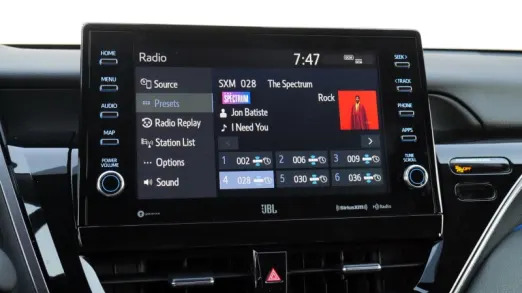
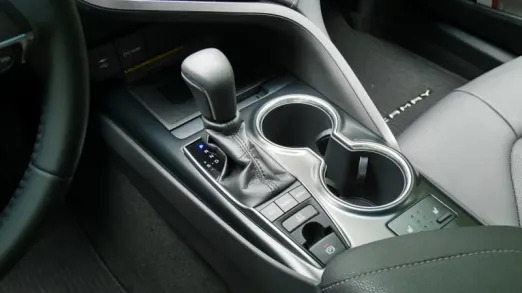
How big is the Camry?
If it weren't for the colossal Honda Accord, the Toyota Camry would stand out for its interior space. The lowered roof of the latest generation may make some folks feel like they're oddly close to the ceiling (especially with a sunroof), but headroom's still OK, and legroom is abundant. Someone 6-foot-3 can even sit behind another without knees grazing the seatback. We also like that the latest Camry has a lower driver seating position than prior generations, making it feel like you're sitting in the car rather than on it.
The trunk offers 15.1 cubic-feet of space, which is less than an Accord or a Sonata. In comparison to the Accord in particular, the trunk is a bit narrower and not as deep. However, that says more about those other sedans than the Camry. The trunk's still really big, with enough room for five roller bags and plenty left over. You can get a better feel for how much stuff the trunk can hold in our Camry luggage test cargo review.
It should also be noted that the all-wheel-drive and hybrid Camry models have the same trunk space as the regular front-drive versions, but the hybrid’s back seat is a smidgen higher since the battery resides underneath. This difference is unlikely to be noticed, however.


What are the Camry fuel economy and performance specs?
The 2024 Camry is available with the widest variety of powertrain options in the midsize sedan segment.
Things start with the 2.5-liter inline-four that produces 203 horsepower and 184 pound-feet of torque when paired with front-wheel drive (206 hp and 186 lb-ft in the XSE). The optional all-wheel-drive system (AWD) reduces output by a tiny amount. An eight-speed automatic is standard.
Fuel economy for the base engine varies depending on trim level and drivetrain. The volume-selling LE and SE with front-wheel drive achieve an excellent 28 mpg city, 39 mpg highway and 32 mpg combined. The XLE and XSE take a minor hit at 31 mpg combined. All-wheel drive takes a further dive, especially on the highway, to 25/34/29 in the LE and SE, and then 25/34/28 for the XLE and XSE AWD.
The optional 3.5-liter V6 is paired exclusively with front-wheel drive and the eight-speed automatic. It produces a whopping 301 horsepower and 267 pound-feet of torque. Unlike some turbocharged engines that require premium fuel to achieve max performance, the Camry's V6 runs on regular. Fuel economy is still strong at 22 mpg city, 33 mpg highway and 26 mpg combined for the XLE. The XSE gets 22/32/26, and the TRD trim brings up the rear at 22/31/25.
Finally, the Camry Hybrid uses a pair of electric motors in conjunction with a four-cylinder engine. Together, they produce a combined 208 hp. The Camry Hybrid LE trim level returns 51 mpg city, 53 mpg highway and 52 mpg combined. The other trims are 44/47/46, a difference that isn't as significant as the mpg figures make it seem. They also aren’t that different than those of the Toyota Prius.
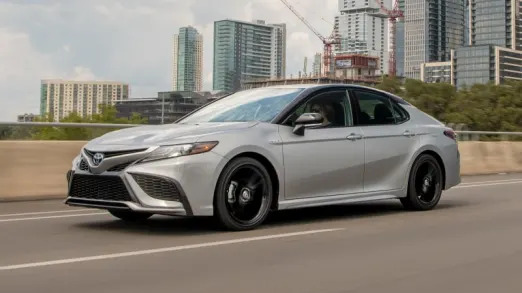
Camry XSE (silver) and XLE (blue).
What's the Camry like to drive?
Forget all your preconceived notions of the Toyota Camry. It is a far more involving car than previous generations with sharper, more composed handling and pleasantly responsive steering. Everything gets a bit tighter in the SE and XSE trims, but choosing them isn't an absolute must anymore for folks who like to drive. True, the Honda Accord remains a superior drivers' car, but the Camry isn't so far off.
In fact, the Camry TRD was seemingly made to make that very point, as it's outfitted with track-tuned chassis components, a strengthened structure and enhanced steering to deliver handling that approaches sport sedan territory, at the expense of a less-forgiving ride.
The TRD comes standard with the muscular V6 engine that's optional on other Camrys. No matter the trim, though, this is a strong, smooth engine that only gets better when you realize it matches the fuel economy of its turbocharged four-cylinder competitors. Of course, few people get the V6 (only 6%). The majority go for the base four-cylinder that offers best-in-class power, but when it's compared to turbocharged engines, you'll likely notice that it has less low-end grunt and sounds a bit winded when pushed. It's certainly not Toyota's most refined effort, although at least it has a capable partner in the smart eight-speed automatic that's greatly superior to the CVTs found in most competitors. All of that pretty much carries over to the Camry AWD that’s only offered with the base four-cylinder.
Finally, there's the Camry Hybrid, which we think is the pick of the litter. Its electric motor adds the low-end pull the base four-cylinder lacks, while also smoothing things out considerably. Furthermore, the battery's placement under the back seat lowers the car's center of gravity and lessens the front weight bias, making for improved dynamics around corners. A heavy right foot still results in a fair bit of droning from the powertrain (something you don't get in the Hyundai Sonata Hybrid), but it is better than past Toyota hybrid efforts, as is the brake-pedal modulation. That you can now get it in the sportiest, more luxurious XSE guise is icing on the cake.
What other Toyota Camry reviews can I read?
2020 Toyota Camry AWD First Drive
Our first drive of the all-wheel-drive Camry, including information about its engineering. You see, all-wheel drive wasn't meant to be in the new Camry. Then things changed.

2020 Toyota Camry TRD First Drive
And now for something completely different ... We take a spin around Texas Motor Speedway in the unlikeliest Camry, a high-performance one tuned by Toyota's TRD wing. We later got a chance to drive it back at Autoblog HQ in Michigan.

Toyota Camry Luggage Test | How much fits in the trunk?
We put the 15.1-cubic-foot Camry trunk to the real-world test by seeing how much luggage (and other stuff) we can fit in its trunk.
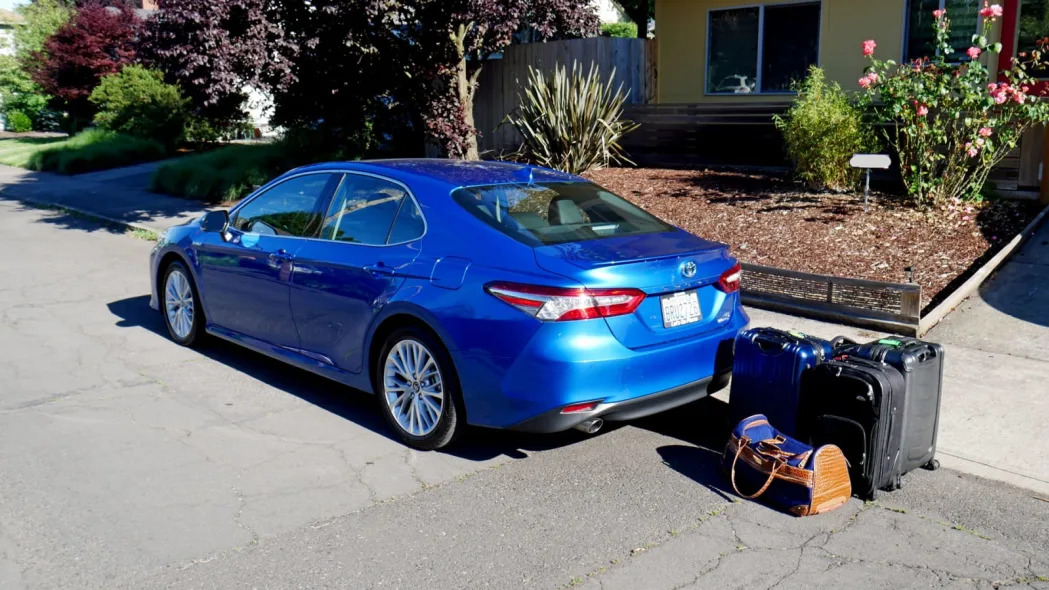
What is the 2024 Camry price and where is it built?
The Camry is built in Georgetown, Kentucky, with prices that start at $27,515.
Unlike in the past, the base model Camry is actually very well equipped, and interior quality doesn’t take a major hit. In fact, we’ve rented a Camry LE and came away impressed with how much car and equipment you get at the base level.
From the LE, the Camry lineup forks in multiple directions. The SE trims are sportier to look at and to drive, with their Nightshade variants adding darker trim and nifty bronze-colored wheels. The XSE slathers on extra convenience and luxury equipment onto the SE’s mechanical setup. The XLE basically takes those same convenience and luxury extras, but applies them to the LE’s design and more comfort-oriented setup. The TRD, meanwhile, is the wild child of the family, with a performance-oriented chassis and boy racer exterior add-ons that include a unique deck wing.
All prices below include the $1,095 destination charge. All-wheel drive is an option on the LE, SE, SE Nightshade, XLE and XSE when equipped with the base engine.
LE: $27,515
SE: $29,055
SE Nightshade: $30,055
XLE: $32,265
XSE: $32,815
TRD: $34,580
XLE V6: $37,390
XSE V6: $37,940
LE Hybrid: $29,950
SE Hybrid: $31,485
SE Nightshade Hybrid: $32,485
XLE Hybrid: $34,840
XSE Hybrid: $35,390
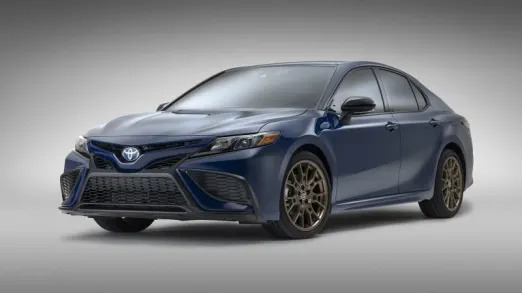

SE Nightshade
What are the Camry safety ratings and driver assistance features?
The Camry has earned very high crash-test scores. It's an IIHS Top Safety Pick + having earned the highest marks in the pertinent crash tests, along with top marks for its collision prevention system and even LATCH child seat anchor access (we can confirm in our own testing that they're very easy to use). Its headlights perform decently, too, with most of versions receiving the second-highest “Acceptable" rating, and XLE Hybrid's adaptive headlights getting the top "Good" rating. NHTSA ranks the Camry highly, too, with an overall five-star rating, including five-star ratings for each individual crash test.
The Camry comes well-equipped with many standard safety and driver assist features. Although Toyota advertises its own specific terms of these features, they are generically known as forward collision warning, automatic emergency braking, lane-departure warning, lane-keeping assist, automatic high-beam headlights, rear-seat reminder warning and adaptive cruise control with lane-centering steering assist. TRD, XLE and XSE models also receive blind-spot and rear cross-traffic warning, which are also available on some LE and SE models.

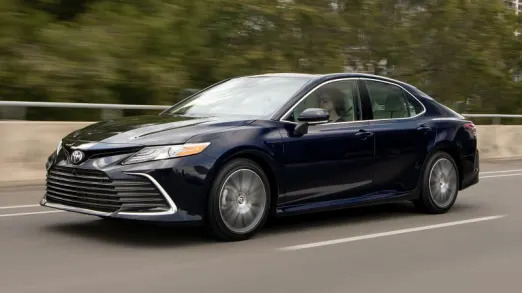








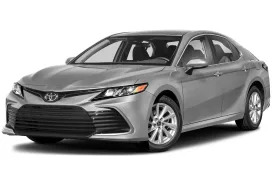



Sign in to post
Please sign in to leave a comment.
Continue